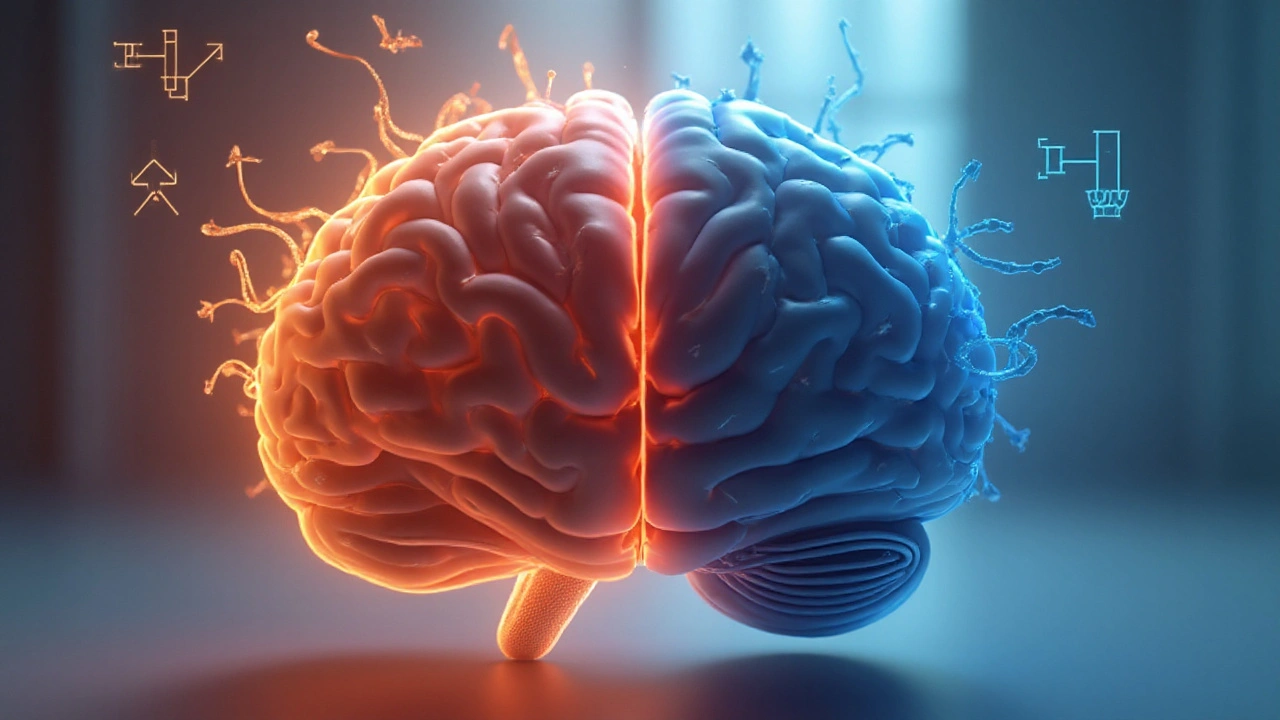Obsessive-Compulsive Disorder (OCD) is a chronic anxiety condition marked by unwanted intrusive thoughts (obsessions) and ritualistic actions (compulsions) to neutralize anxiety. It usually appears in late teens or early adulthood and can dominate daily life.
Obsessive-Compulsive Personality Disorder (OCPD) is a pervasive personality style defined by perfectionism, rigid adherence to rules, and a need for control that impairs flexibility and relationships. Unlike OCD, the symptoms are ego‑syntonic, meaning the person often sees them as normal.
Why the Confusion Matters
Both conditions share the OCD and OCPD label, which leads many to think they’re the same. In reality, they occupy distinct spots on the mental‑health spectrum. Clinicians who blur the line risk misdiagnosing, prescribing ineffective treatment, or overlooking comorbid issues like anxiety disorders.
Clinical Overlap and Core Differences
At a superficial level, both disorders involve a preoccupation with order and control. The Anxiety Disorders umbrella captures OCD, while OCPD lives within the Personality Disorders category. The key distinction is distress: people with OCD experience significant distress and try to resist their compulsions; those with OCPD often feel satisfied by their meticulousness and may not recognize it as a problem.
Diagnostic Criteria in the DSM‑5
The Diagnostic and Statistical Manual of Mental Disorders (DSM‑5) spells out separate criteria. OCD requires at least one obsession and one compulsion that consume more than an hour daily and cause functional impairment. OCPD, on the other hand, lists five or more traits such as excessive devotion to work, inflexibility about morals, and over‑scrupulousness about details. Recognizing these cut‑offs helps clinicians choose the right assessment tools.
Neurobiological Links
Neuroimaging studies consistently implicate the basal ganglia and the orbitofrontal cortex in OCD. OCPD shows less dramatic structural changes but shares similar patterns of heightened activity in the same circuits, suggesting a common neurobiological substrate. Moreover, the neurotransmitter serotonin plays a central role in both conditions, which explains why selective serotonin reuptake inhibitors (SSRIs) can alleviate symptoms across the board.
Treatment Strategies: Where They Converge and Diverge
The gold‑standard treatment for OCD is Cognitive‑Behavioral Therapy (CBT) with exposure and response prevention (ERP). SSRIs are the first‑line pharmacological option. For OCPD, psychotherapy focuses on insight‑oriented approaches, such as schema‑focused therapy, and may incorporate CBT techniques to increase flexibility. Medications are less effective unless the patient has comorbid OCD or severe anxiety.

Comorbidity and Personality Traits
It’s common to see OCD and OCPD co‑occur with other Mood Disorders, Depressive Episodes, or even Tourette Syndrome. The presence of OCPD traits-like perfectionism and over‑control-can exacerbate OCD‑related distress, creating a feedback loop that fuels both conditions. Clinicians should screen for these personality characteristics to tailor interventions.
Practical Assessment Checklist
- Ask about intrusive thoughts that feel unwanted (OCD) versus persistent preferences for order that feel "just right" (OCPD).
- Gauge distress: does the behavior cause anxiety or embarrassment?
- Identify functional impact: missed work, relationship strain, or avoidance of daily activities.
- Screen for comorbid anxiety, depression, or other personality disorders.
- Consider neuropsychological testing if the diagnosis remains ambiguous.
Comparison Table: OCD vs OCPD
| Feature | Obsessive‑Compulsive Disorder | Obsessive‑Compulsive Personality Disorder |
|---|---|---|
| Core Issue | Intrusive obsessions & compulsions | Rigid perfectionism & control |
| Insight | Usually good; recognizes irrationality | Often limited; sees behavior as correct |
| Onset Age | Late teens - early 20s | Early adulthood, often stable |
| Distress Level | High - causes anxiety | Low - may be ego‑syntonic |
| Treatment | CBT‑ERP, SSRIs | Psychodynamic or schema‑focused therapy; CBT for flexibility |
| Diagnostic Manual | DSM‑5 Anxiety Disorders | DSM‑5 Personality Disorders |
Implications for Everyday Life
Understanding the distinction helps people recognize when a loved one’s "need for order" is a harmless personality quirk versus a debilitating compulsion. It also informs workplace accommodations: OCD may require time‑limited breaks for rituals, while OCPD may benefit from coaching on delegation and flexibility.
Next Steps for Readers
If you suspect OCD, schedule a clinical interview that includes the Yale‑Brown Obsessive Compulsive Scale. For OCPD, request a personality assessment like the MMPI‑2. In either case, combine therapy with lifestyle changes-regular exercise, sleep hygiene, and mindfulness can reduce overall anxiety and improve treatment response.

Frequently Asked Questions
Can someone have both OCD and OCPD?
Yes. Co‑occurrence is common, especially when perfectionistic traits amplify obsessive thoughts. Dual diagnosis often requires an integrated treatment plan that addresses both anxiety‑driven compulsions and rigid personality patterns.
How do SSRIs help if OCPD isn’t an anxiety disorder?
SSRIs increase serotonin levels, which can soften the intensity of perfectionistic urges and reduce underlying anxiety that fuels OCPD‑related rigidity. They’re most useful when OCPD co‑exists with OCD or significant anxiety.
Is CBT effective for OCPD if the person doesn’t see a problem?
Traditional CBT can be challenging because motivation hinges on perceived need for change. Therapists often start with motivational interviewing to build insight before applying CBT techniques aimed at flexibility.
What are early warning signs that a perfectionist might have OCPD?
Look for an extreme need to control schedules, difficulty delegating tasks, and a pattern of over‑working that interferes with relationships or health. Unlike OCD, these traits are usually welcomed by the individual as "just the way they are."
Can lifestyle changes replace therapy for mild OCD?
Lifestyle tweaks-regular exercise, sleep consistency, reduced caffeine-can lower baseline anxiety, but they rarely eliminate compulsions on their own. For lasting improvement, a structured CBT‑ERP program is typically recommended.


Geneva Angeles
September 24, 2025 AT 17:01When you dive into the neurobiology of OCD and OCPD you start to see a fascinating overlap that often gets lost in the hype of diagnostic manuals. The basal ganglia and orbitofrontal cortex light up like neon signs whenever a person with OCD is wrestling with an intrusive thought, and the same circuits whisper their presence in OCPD, albeit at a lower volume. This shared circuitry explains why SSRIs can sometimes smooth out the perfectionist edge of OCPD, even though the core motivation differs. Imagine a person who spends hours arranging their desk because the world feels chaotic; the anxiety that fuels that compulsion is a cousin of the anxiety that drives the obsessions in OCD. It’s a reminder that mental health isn’t a set of isolated boxes but a web of interlocking processes. You can use this knowledge to tailor treatment – perhaps start with CBT‑ERP for the compulsive side while weaving in schema‑focused therapy to gently challenge the rigid self‑standards of OCPD. The key is to keep the client engaged, because motivation can evaporate when the therapist sounds like a judge. In practice, setting tiny, measurable goals, like allowing a coffee mug to sit slightly askew for one day, can create a ripple effect of flexibility. The more you respect the person’s ego‑syntonic view, the more likely they’ll cooperate with exposure techniques that feel less like punishment and more like a collaborative experiment. Don’t forget the power of lifestyle interventions; regular cardio, proper sleep hygiene, and mindfulness can lower baseline serotonin demand, making medication more effective. And when comorbidities like depression or Tourette’s enter the picture, a multidisciplinary approach becomes essential. So, the next time you encounter a patient who insists that their meticulousness is simply “how they are built,” you have a toolbox full of strategies that bridge the gap between obsessive thought streams and personality‑driven perfectionism. Keep pushing forward, keep integrating the science, and watch those rigid patterns begin to soften.
Scott Shubitz
September 25, 2025 AT 11:46Let's cut through the fluffy optimism and acknowledge that the DSM's neat categories often hide a messy reality, where clinicians slap the wrong label on a patient and then prescribe a cocktail that does nothing but flood the system with side‑effects. The overlap in circuitry is a double‑edged sword: it can mislead prescribers into thinking one pill will fix both, when in fact the therapeutic pathways diverge sharply after the first few weeks. You need to watch for the tell‑tale signs of ego‑syntonic rigidity; otherwise, you're just feeding a perfectionist's ego with more medication.
Soumen Bhowmic
September 26, 2025 AT 06:40Building on that point, it's crucial to remember that therapy isn't a one‑size‑fits‑all venture. When a client shows both compulsive rituals and a deep‑seated need for order, an integrated approach that blends exposure‑response prevention with schema therapy can create a synergistic effect. Start by mapping out the specific triggers-whether they're intrusive images or the fear of a project not being "just right"-and then gradually introduce flexibility drills. Over time, the client can learn to tolerate a slightly crooked picture frame without spiraling into a full‑blown anxiety episode. It's all about pacing and respecting the individual's lived experience while gently expanding their comfort zone.
Jenna Michel
September 27, 2025 AT 01:33From a motivational standpoint, think of OCD and OCPD as two sides of the same neuro‑cognitive coin, with the basal ganglia acting as the central processor. When you engage clients in goal‑oriented behavioral activation, you tap into those same circuits but redirect them toward adaptive habits. Leveraging psycho‑education about serotonin's role can demystify why SSRIs sometimes feel like a "magic bullet" and other times just a placebo. In practice, coupling pharmacotherapy with structured skill‑building sessions-like time‑boxing tasks or progressive muscle relaxation-creates a multi‑modal pathway to recovery.
Abby Richards
September 27, 2025 AT 20:26Great summary! 😊
Lauren Taylor
September 28, 2025 AT 15:20Incorporating an inclusive mentorship model can really help de‑stigmatize both disorders, especially when you frame the conversation around shared neuro‑biological substrates rather than moral failings. Encouraging participants to discuss their perfectionistic tendencies in a safe group setting fosters communal insight and reduces the isolation often felt by those with OCPD. Moreover, using jargon like "cognitive rigidity" and "behavioral inhibition" in plain language empowers clients to understand the mechanics behind their symptoms, which in turn promotes self‑efficacy and adherence to treatment protocols.
Vanessa Guimarães
September 29, 2025 AT 10:13Honestly, the whole "they're different" narrative feels like a bureaucratic smokescreen designed to keep insurance companies happy while clinicians chase titles. The reality is that the human brain doesn't read those chapter headings, and neither should we.
Lee Llewellyn
September 30, 2025 AT 05:06While the clinical distinctions are academically neat, most people on the ground just want relief, not a lecture on DSM categories. So why not cut the jargon and focus on pragmatic strategies that actually move the needle?
Drew Chislett
October 1, 2025 AT 00:00It's refreshing to see a post that blends science with actionable advice, and I especially appreciate the emphasis on lifestyle tweaks alongside therapy. Small wins in sleep and exercise can make a world of difference.
Rosalee Lance
October 1, 2025 AT 18:53From a philosophical angle, one might argue that the pursuit of perfection is an existential quest for meaning, yet when it morphs into pathology, it reveals the fragile boundary between self‑actualization and self‑destruction.
Kara Lippa
October 2, 2025 AT 13:46Thanks for the thorough breakdown; I'll definitely share this with a friend who's struggling with compulsive checking.
Puneet Kumar
October 3, 2025 AT 08:40Considering cultural variations in how perfectionism manifests, it's important to tailor assessments to the individual's background, ensuring that we don't pathologize culturally normative behaviors.
michael maynard
October 4, 2025 AT 03:33Honestly, most of this sounds like a textbook read‑through. Real people don't sit down and fill out checklists; they deal with messy emotions and daily frustrations that no manual can capture.
Roger Bernat Escolà
October 4, 2025 AT 22:26One thing that often gets missed is the role of emotional regulation training; teaching clients to identify and label their affect can reduce the intensity of both obsessions and rigid perfectionist drives.
Allison Metzner
October 5, 2025 AT 17:20Some might wonder if the pharmaceutical industry is secretly steering us toward over‑medicating these so‑called "disorders" to keep the profit wheels turning.
william smith
October 6, 2025 AT 12:13For clinicians, an efficient way to differentiate OCD from OCPD is to ask whether the behavior causes distress or is experienced as "just right".
Timothy Javins
October 7, 2025 AT 07:06It's worth noting that the overlap in serotonin pathways doesn't automatically justify identical treatment plans.
Kay Yang
October 8, 2025 AT 02:00Having lived in both collectivist and individualist cultures, I can attest that the expression of perfectionism can look very different, yet the underlying rigidity often remains the same.
Rajesh Kumar Batham
October 8, 2025 AT 20:53Thanks for the insightful post! It's encouraging to see the emphasis on both medication and psychotherapy, as the best outcomes usually come from a balanced approach.
Bill Gallagher
October 9, 2025 AT 15:46To summarize, the diagnostic criteria for OCD require the presence of at least one obsession and one compulsion that significantly impair functioning; in contrast, OCPD is diagnosed when an individual exhibits five or more of the characteristic personality traits, such as excessive devotion to work and inflexibility about morals, without necessarily experiencing the distress that characterizes OCD; consequently, while both conditions may share neurobiological substrates-particularly involving the orbitofrontal cortex and basal ganglia-the therapeutic implications diverge, with OCD responding robustly to exposure and response prevention combined with SSRIs, whereas OCPD often benefits more from insight‑oriented psychotherapy aimed at increasing cognitive flexibility and reducing maladaptive perfectionism; clinicians must therefore conduct a nuanced assessment, incorporating both symptom checklists and personality inventories, to determine the most appropriate intervention plan for each individual.